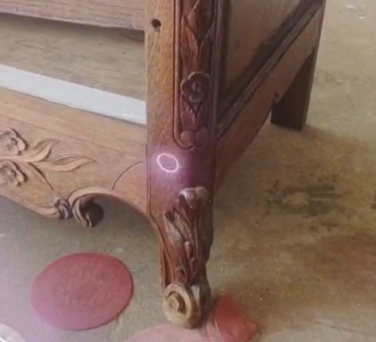Restoring a piece of wooden heritage often begins with a moment of hesitation. The desire to reveal the original surface is weighed against the risk of permanent damage. Aggressive sanding can obliterate fine details and historical tool marks, while harsh chemical strippers can saturate and stain the wood, creating a new set of problems. This compromise between cleaning and preservation has frustrated restorers for decades. Today, a new solution—laser paint removal from wood—is revolutionizing the field. This guide explores the science, benefits, and practical applications of this precise, efficient, and environmentally friendly technology.
How Does Laser Cleaning Work on Wood?
Using a high-energy laser on a delicate material like wood might seem like a recipe for disaster. However, the technology is not about brute force but about scientific precision. The process relies on a principle called laser ablation, which allows for the removal of unwanted layers like paint or varnish without harming the underlying wood.
What is Laser Ablation?
Laser ablation is the process where a laser beam removes a material or coating from a surface. The laser is precisely calibrated to interact only with the top layer (such as paint) and leave the material underneath untouched.
The key to the process is selectivity. A laser’s specific wavelength and pulse duration are chosen so that the energy is absorbed by the paint but reflected by the underlying wood. Once the paint is vaporized, the laser energy no longer affects the wood substrate, leaving it clean and undamaged.
The Laser Cleaning Process
The process of using a laser to clean wood can be broken down into the following steps:
-
Targeted Energy Delivery: A focused beam of light, made of intense energy pulses, is aimed at the painted surface.
-
Rapid Vaporization: The paint or coating absorbs the laser’s energy. This intense, localized heat causes the coating to instantly vaporize, turning the solid material directly into gas and fine particles.
-
Bond Separation: As the coating turns to gas, its bond with the surface beneath is broken, effectively lifting it away.
-
Substrate Preservation: Because the laser is calibrated specifically for the coating, it does not harm the underlying wood, ensuring the surface remains intact.
Key Laser Systems for Wood Cleaning
For cleaning wood, the type of laser system used is critical. Pulsed laser cleaners are the undisputed industry standard, while Continuous Wave (CW) systems are entirely unsuitable.
-
Operation: Deliver energy in incredibly short, intense bursts or “pulses.”
-
Benefit: This process gives the wood surface a fractional moment to cool between each pulse.
-
Result: The cooling period is critical for preventing heat buildup and avoiding any charring or burning of the delicate wood underneath.
-
Application: Prized for their efficiency, reliability, and the precise control they offer, making them ideal for wood.
Why Use a Laser for Paint Removal?
When compared to traditional methods, choosing laser paint removal from wood offers significant advantages that address common challenges in wood restoration, including precision, safety, and efficiency.
The Advantages of Laser Paint Removal
Unmatched Precision and Gentleness
The most significant benefit of laser cleaning is that it is a non-contact and non-abrasive process. This allows for an incredible level of detail and preservation of the underlying material.
-
It leaves the original wood grain completely intact.
-
It preserves historical details, such as a craftsman’s original tool marks.
-
It does not disturb the delicate patina that develops on wood with age.
Eco-Friendly Process
Laser cleaning is considered a green technology because it works without harsh chemicals or solvents.
-
It eliminates the need for chemical strippers.
-
It produces no secondary hazardous waste, unlike chemical processes.
Enhanced Efficiency
Manual or mechanical paint stripping is known for being slow and labor-intensive. A laser system operates at a much faster pace.
-
It cleans surfaces at a consistent and rapid speed.
-
It significantly reduces the man-hours required for a project.
-
It helps accelerate project timelines.
Superior Safety
When operated with the correct protocols, laser systems create a safer working environment compared to other methods.
-
It avoids creating the large dust clouds associated with mechanical sanding.
-
When paired with an integrated fume extractor, the system captures particles at the point of creation.
Cost-Effective in the Long Run
While the initial investment in a laser system is high, it can be a highly cost-effective solution for commercial operations over time.
-
It eliminates the recurring costs of consumables like chemicals and sandpaper.
-
It removes the need for expensive hazardous waste disposal services.
A Comparative Analysis: Laser vs. Traditional Paint Removal
To understand the value of laser paint removal from wood, it is helpful to compare it directly against conventional methods like chemical stripping and mechanical sanding. The differences in surface impact, safety, and environmental effects are significant.
Comparison: Laser, Chemical, and Mechanical Methods
| Property | Laser Removal | Chemical Stripping |
Mechanical Methods (Sanding)
|
| Surface Impact | Non-contact, no surface damage | Can raise the grain and leave residue |
Abrasive, causes swirl marks and flattens edges
|
| Effect on Details | Preserves intricate patterns and sharp edges | Can soften or damage delicate details |
Destroys fine details and craftsmanship
|
| Waste Product | Contained dust and fumes, managed by an extractor | Toxic chemical sludge requiring special disposal |
Large volumes of airborne dust
|
| Process Type | Dry process, surface is immediately ready for finishing | Wet process, requires drying and neutralization |
Dry process, but leaves an abraded surface
|
Laser Removal vs. Chemical Stripping
Chemical stripping involves applying a solvent to dissolve paint, a method with major challenges that laser cleaning overcomes.
Health and Environment
-
Chemical Stripping: This method releases volatile organic compounds (VOCs) and creates a toxic sludge that is costly and difficult to dispose of safely.
-
Laser Removal: The laser process is self-contained. When paired with a fume extractor, it produces no secondary chemical waste.
Wood Integrity
-
Chemical Stripping: Harsh chemicals can be absorbed by porous wood, which can raise the grain and leave behind residues that compromise the adhesion and appearance of new finishes.
-
Laser Removal: This is a dry process that leaves a pure, unaltered surface ready for immediate finishing.
Laser Removal vs. Mechanical Methods (Sanding, Blasting)
Mechanical methods use friction or impact to wear away the paint layer. While effective, they are inherently aggressive and can damage the wood.
Surface Damage
-
Mechanical Methods: Sanding is abrasive and can easily create swirl marks, flatten sharp edges, and erase the original texture of the wood. This is its primary drawback.
-
Laser Removal: Because the process is non-contact, it completely avoids these risks, preserving the original surface.
Intricate Details
-
Mechanical Methods: It is virtually impossible to sand complex carvings or patterns without destroying the fine craftsmanship.
-
Laser Removal: The laser beam can be finely focused to clean these delicate areas perfectly without causing harm.
Airborne Contaminants
-
Mechanical Methods: Sanding and blasting generate a large volume of airborne dust, which can be hazardous.
-
Laser Removal: A laser system with an integrated fume extractor captures these particles at their source, preventing them from contaminating the air.
The Laser Paint Removal Process: A Step-by-Step Guide
Laser paint removal is a highly controlled and systematic process that relies on methodical execution to achieve perfect results.
-
Initial Assessment & Surface Preparation: A technician identifies the wood type and coating to determine initial settings. The surface is cleaned of loose dirt.
-
Calibration and Spot Testing: This is the most critical phase. Using a small, inconspicuous area, the operator adjusts the laser’s power, pulse frequency, and speed to find the precise “ablation threshold”—the setting that vaporizes paint without affecting the wood.
-
Controlled Laser Application: The operator moves the laser optic methodically across the surface. Throughout the process, the technician monitors the results to ensure a consistent finish.
-
Fume Extraction and Safety: Simultaneously, a high-powered fume extractor nozzle is positioned at the point of ablation to capture all vaporized particles and gases. This is a non-negotiable safety step.
-
Final Inspection and Post-Treatment: The surface is inspected for uniformity. Any fine residue is gently wiped away, leaving a clean, dry surface immediately ready for a new finish.
Economic Considerations: A Cost-Benefit Analysis
For many, the decisive factor comes down to cost. While the upfront investment is high, the project-based costs are highly competitive.
Hiring a Professional Service vs. DIY
Due to the extreme cost of equipment (tens to hundreds of thousands of dollars) and the critical need for safety certification, DIY laser paint removal is not a feasible or recommended option for individuals.
The practical and safe choice is to hire a specialized laser cleaning service. This provides access to state-of-the-art equipment and the skill of a trained technician. The cost of hiring a professional will depend on:
-
Total Area: The overall square footage.
-
Coating Complexity: The type, thickness, and number of paint layers.
-
Site Accessibility: Whether the item is in a workshop or requires on-site work.
What Are the Limitations and Risks of Laser Cleaning?
While powerful, laser cleaning technology is not a universal solution for all wood restoration projects. Understanding its limitations, challenges, and the mandatory safety protocols is crucial for its proper and effective use.
Limitations and Challenges
Material and Coating Constraints The effectiveness of a laser depends heavily on the type of coating and the wood itself.
-
Lead-Based Paint: A laser can remove lead paint, but doing so vaporizes the lead and creates highly toxic fumes. This process requires specialized, certified fume extraction systems and containment protocols, which increases project complexity and cost.
-
Penetrating Stains: Laser ablation works by removing surface layers. It is ineffective against stains that have soaked deep into the wood fibers, as there is no distinct layer to remove.
-
Heat-Sensitive Woods: Certain softwoods with a high resin content, such as pine, can be scorched if the laser settings are not perfectly calibrated. This requires a high level of operator skill to prevent damage.
Operational Challenges
-
Line-of-Sight Requirement: The laser beam travels in a straight line. It cannot clean around corners or in tight areas where the laser head cannot be directly pointed at the surface.
-
High Initial Cost: The significant capital investment for the equipment remains the largest barrier to widespread adoption. This keeps the technology primarily in the hands of specialized commercial contractors.
Case Studies and Real-World Applications
-
Architectural Restoration: Used on historic buildings to remove decades of paint from timber beams and ornate facades without damaging the historic fabric.
-
Antique Furniture Restoration: Trusted by conservators to restore priceless antiques by cleaning intricate carvings and veneers that would be destroyed by other methods.
-
Industrial Cleaning: Employed in manufacturing to clean residues from wooden molds and patterns quickly and without altering their precise dimensions.
Essential Safety Protocols
Adhering to a strict set of safety protocols is not just recommended—it is absolutely mandatory.
-
Personal Protective Equipment (PPE): This includes laser safety goggles rated for the specific laser wavelength, respirators to protect from fumes, and protective, non-flammable clothing.
-
Work Area Safety: The area must have a professional fume extraction system, be cleared of all flammable materials, and have a suitable fire extinguisher readily accessible. Operators must be fully trained and adhere strictly to the manufacturer’s guidelines.
Frequently Asked Questions (FAQ)
1. Is laser paint removal completely safe for all wood?
It is safe for most wood types when performed by a trained technician. The key is proper calibration. For very soft or resinous woods, there is a risk of scorching if not done correctly. It is not effective for removing penetrating stains.
2. Can I use a laser to remove lead paint from wood?
Yes, but it is a highly specialized task. The laser vaporizes the lead, creating toxic fumes that must be captured by a certified filtration system. This should only be performed by professionals with the proper equipment and containment protocols.
3. Is laser paint removal more expensive than chemical stripping or sanding?
The upfront cost for hiring a laser service can be higher than buying a can of chemical stripper. However, when factoring in the total cost—including labor, materials, hazardous waste disposal, and the cost of repairing damage caused by other methods—laser removal is often highly cost-competitive, especially for high-value items.
Conclusion: The Future of Wood Restoration
Laser paint removal marks a paradigm shift in wood restoration. It offers an unparalleled combination of precision, efficiency, and environmental responsibility. While not yet a universally accessible tool, it has firmly established itself as the gold standard for high-value projects where substrate preservation is the top priority. As the technology becomes more refined and affordable, it is poised to become a cornerstone of the professional restoration and conservation industries, ensuring the beauty of our wooden heritage can be preserved with more fidelity than ever before.
Post time: Jun-25-2025













